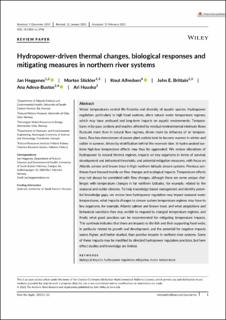| dc.description.abstract | Water temperatures control life histories and diversity of aquatic species. Hydropowerregulation, particularly in high head systems, alters natural water temperature regimes,which may have profound and long-term impacts on aquatic environments. Tempera-tures in by-pass sections and reaches affected by residual/environmental minimum flowsfluctuate more than in natural flow regimes, driven more by influence of air tempera-tures. Reaches downstream of power plant outlets tend to become warmer in winter andcolder in summer, driven by stratification behind the reservoir dam. In hydro-peaked sys-tems high-low temperature effects may thus be aggravated. We review alterations ofhydropower to natural thermal regimes, impacts on key organisms in terms of survival,development and behavioral thresholds, and potential mitigation measures, with focus onAtlantic salmon and brown trout in high northern latitude stream systems. Previous syn-theses have focused mainly on flow changes and ecological impacts. Temperature effectsmay not always be correlated with flow changes, although there are some unique chal-lenges with temperature changes in far northern latitudes, for example, related to theseasonal and colder climates. To help knowledge-based management and identify poten-tial knowledge gaps, we review how hydropower regulation may impact seasonal watertemperatures, what impacts changes to stream system temperature regimes may have tokey organisms, for example, Atlantic salmon and brown trout, and what adaptations andbehavioral variations they may exhibit to respond to changed temperature regimes, andfinally what good practices can be recommended for mitigating temperature impacts.This synthesis indicates that there are impacts to the fish and their supporting food webs,in particular related to growth and development, and the potential for negative impactsseems higher, and better studied, than positive impacts in northern river systems. Someof these impacts may be modified by directed hydropower regulation practices, but hereeffect studies and knowledge are limited. | en_US |

